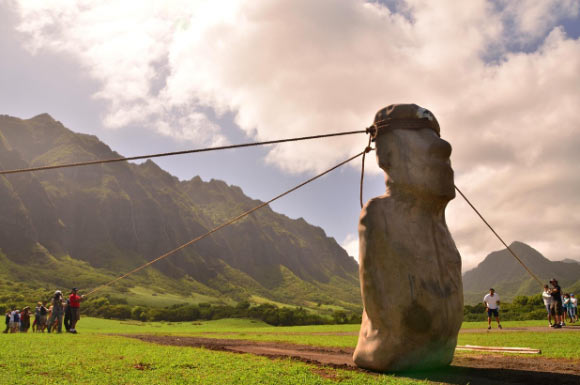The transport of Rapa Nui’s (Easter Island) monumental moai statues has been debated for over a century. Based on a systematic analysis of 962 moai, with a focus on 62 road statues, combined with 3D modeling and field experiments, Binghamton University Professor Carl Lipo and University of Arizona’s Dr. Terry Hunt demonstrated that small groups of the ancient people of Rapa Nui likely used rope and ‘walked’ the giant statues in a zig-zag motion along carefully designed roads.

Carl P. Lipo & Terry L. Hunt confirmed via 3D modeling and field experiments that the ancient people of Rapa Nui ‘walked’ the moai statues. Image credit: Carl Lipo.
Professor Lipo and his colleagues had previously demonstrated via experimental evidence that the large statues ‘walked’ from their quarry to ceremonial platforms using an upright, rocking motion, challenging a theory that the statues were moved lying prone on wooden devices.
“Once you get it moving, it isn’t hard at all — people are pulling with one arm. It conserves energy, and it moves really quickly,” Professor Lipo said.
“The hard part is getting it rocking in the first place. The question is, if it’s really large, what would it take?”
“Are the things that we saw experimentally consistent with what we would expect from a physics perspective?”
To explore how a larger statue might move, Professor Lipo and Dr. Hunt created high-resolution 3D models of the moai and identified distinctive design features — wide D-shaped bases and a forward lean — that would make them more likely to be moved in a rocking, zig-zagging motion.
Putting their theory to the test, they built a 4.35-ton replica moai with the distinct ‘forward-lean’ design.
With just 18 people, they were able to transport the moai 100 m in just 40 minutes, a marked improvement over previous vertical transport attempts.
“The physics makes sense,” Professor Lipo said.
“What we saw experimentally actually works. And as it gets bigger, it still works.”
“All the attributes that we see about moving gigantic ones only get more and more consistent the bigger and bigger they get, because it becomes the only way you could move it.”
Adding to the support for this theory are the roads of Rapa Nui.
Measuring 4.5 m wide with a concave cross-section, the roads were ideal for stabilizing the statues as they moved forward.
“Every time they’re moving a statue, it looks like they’re making a road. The road is part of moving the statue,” Professor Lipo said.
“We actually see them overlapping each other, and many parallel versions of them.”
“What they are probably doing is clearing a path, moving it, clearing another, clearing it further, and moving it right in certain sequences.”
“So they’re spending a lot of time on the road part.”
“Nothing else currently explains how the moai were moved. The challenge to anyone else is to prove them wrong.”
“Find some evidence that shows it couldn’t be walking. Because nothing we’ve seen anywhere disproves that.”
“In fact, everything we ever see and ever thought of keeps strengthening the argument.”
“Our research also honors the people of Rapa Nui, who achieved a monumental engineering feat with limited resources.”
“It shows that the Rapa Nui people were incredibly smart. They figured this out.”
“They’re doing it the way that’s consistent with the resources they have.”
“So it really gives honor to those people, saying, look at what they were able to achieve, and we have a lot to learn from them in these principles.”
The team’s paper was published in the Journal of Archaeological Science.
_____
Carl P. Lipo & Terry L. Hunt. 2025. The walking moai hypothesis: Archaeological evidence, experimental validation, and response to critics. Journal of Archaeological Science 183: 106383; doi: 10.1016/j.jas.2025.106383







